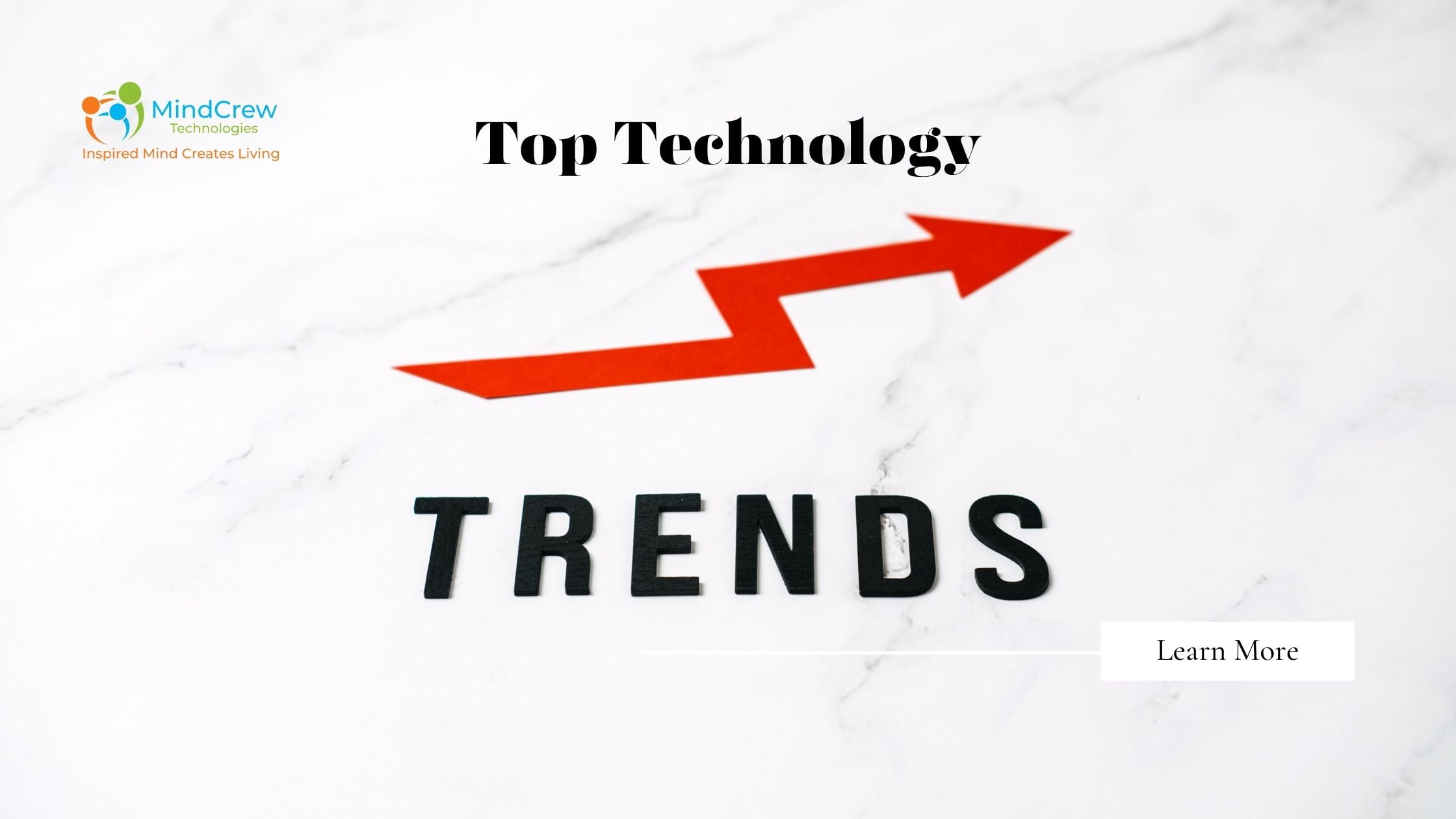Top Technology Trends For 2023
Welcome to the future! The world of technology is constantly evolving, pushing boundaries and revolutionizing the way we live and work. As we look ahead to 2023, it’s clear that exciting advancements are on the horizon. From Artificial Intelligence (AI) and Machine Learning (ML) to Virtual and Augmented Reality (VR/AR), this blog post will explore the top tech trends that will shape our lives in the coming year. Whether you’re a tech enthusiast or simply curious about what lies ahead, join us as we dive into a world of innovation and possibility. So buckle up, because the future is calling!
Artificial Intelligence and Machine Learning
Artificial Intelligence (AI) and Machine Learning (ML) are two groundbreaking technologies that have been making waves in recent years. AI refers to the simulation of human intelligence in machines, enabling them to think and learn like humans. On the other hand, ML focuses on developing algorithms that allow computers to analyze data and make predictions without being explicitly programmed.
One of the key areas where AI and ML have gained significant traction is in mobile app development. With their ability to understand user behavior patterns, these technologies enable developers to create personalized experiences for users. From chatbots providing instant customer support to recommendation systems suggesting relevant content, AI and ML are revolutionizing how apps interact with users.
Moreover, AI-powered voice assistants like Siri and Alexa have become an integral part of our daily lives. These virtual assistants use natural language processing techniques enabled by AI, allowing users to perform tasks hands-free simply by speaking commands.
Another exciting application of AI and ML is in image recognition technology. This has opened up a world of possibilities for augmented reality (AR) applications within mobile apps. Imagine pointing your smartphone at a restaurant menu and instantly seeing reviews or dietary information overlayed on your screen!
Artificial Intelligence and Machine Learning are driving innovation across various industries including mobile app development. Their capabilities offer endless possibilities for creating smarter apps that can provide personalized experiences based on user preferences while also streamlining processes behind-the-scenes. As these technologies continue to evolve, we can expect even more exciting advancements in the near future!
Virtual and Augmented Reality
Virtual and augmented reality (VR/AR) have become buzzwords in the tech industry, promising to revolutionize the way we experience digital content. VR immerses users in a completely virtual environment, while AR overlays digital elements onto the real world.
In recent years, we’ve seen significant advancements in VR/AR technology, with major players like Oculus and Microsoft leading the charge. This has resulted in more accessible and affordable devices, making VR/AR experiences available to a wider audience.
One of the key areas where VR/AR is making an impact is gaming. With VR headsets becoming more comfortable and powerful, players can now step into fully immersive virtual worlds and interact with them like never before.
But it’s not just gaming that stands to benefit from this technology. Industries such as healthcare, education, architecture, and travel are also exploring ways to utilize VR/AR for training simulations, virtual tours, design visualization, and more.
The potential applications of VR/AR are vast and exciting. Imagine being able to attend meetings or collaborate remotely using augmented reality glasses or experiencing historical events through interactive virtual tours. The possibilities are endless!
However, there are still some challenges that need to be overcome for widespread adoption of VR/AR. One major hurdle is creating compelling content that takes full advantage of these technologies’ capabilities without feeling gimmicky or overwhelming.
Additionally, there’s a need for continued research and development to improve hardware performance and address issues like motion sickness that some users may experience when using certain devices.
Despite these challenges though, the future looks bright for virtual and augmented reality. As technology continues to advance, we can expect even more realistic, immersive, and practical applications that will transform various industries. So buckle up!
We’re entering an exciting era where our digital experiences will blur with our physical realities
Internet of Things (IoT)
The Internet of Things (IoT) is revolutionizing the way we interact with everyday objects and devices. It refers to the network of physical objects embedded with sensors, software, and connectivity that enables them to collect and exchange data.
One of the key benefits of IoT is its ability to enhance convenience and efficiency in our daily lives. From smart homes that can adjust temperature settings based on occupancy patterns, to wearable devices that track our health metrics in real-time, IoT has the potential to seamlessly integrate technology into various aspects of our lives.
In addition to improving personal experiences, IoT also holds immense promise for industries such as healthcare, agriculture, transportation, and manufacturing. Imagine hospitals equipped with connected medical devices that can monitor patients remotely or farmers using sensors to optimize irrigation levels based on soil moisture readings.
However, along with these advancements come concerns about privacy and security. As more devices become connected through IoT networks, it becomes crucial for companies and individuals alike to ensure robust cybersecurity measures are in place.
The Internet of Things continues to shape how we live and work by connecting everyday objects in innovative ways. Its potential is limitless as it drives us towards a more connected future where technology seamlessly integrates into every aspect of our lives
5G Technology
5G Technology: Revolutionizing Connectivity
The next big thing in the world of technology is undoubtedly 5G. With its lightning-fast speeds and incredibly low latency, 5G is set to revolutionize connectivity as we know it.
One of the most exciting aspects of 5G is its potential to transform industries such as healthcare, transportation, and entertainment. Imagine being able to download a high-definition movie in mere seconds or perform remote surgeries with virtually no lag time – this is all possible with the power of 5G.
Moreover, 5G will enable the Internet of Things (IoT) to reach new heights. With billions of devices connected seamlessly and communicating at unprecedented speeds, our cities will become smarter and more efficient than ever before.
Another key advantage of 5G is its ability to handle massive amounts of data without any disruptions. This means that mobile apps can leverage this technology to provide users with immersive experiences like never before – whether it’s through augmented reality games or virtual reality training simulations.
In addition, businesses can benefit from faster and more reliable connections for their operations. From improved communication between employees to enhanced productivity through cloud-based services, the possibilities are endless with 5G.
It’s evident that 5G technology holds immense potential for transforming various sectors and enhancing user experiences across the board. As we move towards widespread adoption in the coming years, we can expect a whole new era where connectivity knows no bounds. Stay tuned for an exciting future powered by 5G!
Blockchain and Cryptocurrencies
Blockchain and cryptocurrencies have been making waves in the tech world, revolutionizing industries such as finance, supply chain management, and even healthcare. The blockchain technology essentially provides a decentralized platform for secure transactions and eliminates the need for intermediaries. This has paved the way for digital currencies like Bitcoin and Ethereum to gain popularity.
One of the biggest advantages of blockchain technology is its transparency. Every transaction made on a blockchain network is recorded on a shared ledger that can be accessed by all participants. This ensures trust among users as it eliminates the possibility of fraud or manipulation.
Moreover, cryptocurrencies offer faster and cheaper cross-border transactions compared to traditional banking systems. With no central authority involved, transactions can be processed within minutes regardless of geographical boundaries.
The adoption of blockchain technology is not limited to financial institutions alone. Many businesses are exploring its potential in areas such as supply chain management where it can provide end-to-end visibility and traceability for products.
However, with every new technological advancement comes challenges. One major concern when it comes to cryptocurrencies is security. Since digital currencies are based on cryptographic algorithms, there have been instances of hacking attempts targeting cryptocurrency exchanges and wallets.
To address these concerns, developers are constantly working on improving security measures by implementing advanced encryption techniques and multi-factor authentication protocols.
the emergence of blockchain technology has opened up exciting possibilities across various industries. Its ability to provide transparent and secure transactions makes it an attractive option for businesses looking to streamline their processes while ensuring data integrity.
Cybersecurity and Data Privacy
Cybersecurity and data privacy have become critical concerns in today’s digital landscape. With the increasing reliance on technology, it is vital to protect sensitive information from malicious attacks and unauthorised access.
One of the emerging trends in cybersecurity is the adoption of advanced encryption techniques. Encryption helps safeguard data by converting it into unreadable code that can only be deciphered with the correct decryption key. This ensures that even if attackers manage to intercept the data, they won’t be able to make sense of it.
Another important aspect of cybersecurity is identity verification. As more transactions take place online, verifying the identity of users becomes crucial to prevent fraud and unauthorized access. Innovative technologies such as biometrics (fingerprint or facial recognition) are being integrated into security systems to provide robust authentication methods.
Furthermore, organizations are now focusing on implementing proactive measures rather than reactive ones when it comes to cybersecurity. Instead of simply responding after an attack occurs, businesses are investing in threat intelligence tools and continuous monitoring systems that can identify potential vulnerabilities before they are exploited.
Data privacy has also gained significant attention due to numerous high-profile breaches and scandals involving personal information misuse. Governments around the world have enacted stricter regulations like GDPR (General Data Protection Regulation) which aim at giving individuals more control over their personal data.
To ensure compliance with these regulations, companies need to adopt transparent data practices and implement stringent privacy policies. Additionally, user awareness campaigns can help educate individuals about their rights regarding their personal information and how they can protect themselves online.
As technology continues to advance rapidly, so do cyber threats. It is imperative for businesses and individuals alike to prioritize cybersecurity measures along with maintaining stringent data privacy protocols. By staying vigilant and adopting innovative solutions, we can navigate this digital era securely while safeguarding our valuable information.
Conclusion
In this fast-paced world of technology, staying updated with the latest trends is crucial for businesses and individuals alike. As we look towards the future, it’s clear that several key technologies will shape our lives in 2023 and beyond.
Artificial Intelligence and Machine Learning will continue to revolutionize industries, enabling automation, advanced data analysis, and personalized experiences. Virtual and Augmented Reality will transform how we interact with information and entertainment, creating immersive experiences like never before.
The Internet of Things (IoT) will connect more devices than ever before, making our homes smarter and our cities more efficient. The rollout of 5G Technology promises lightning-fast internet speeds on mobile devices, paving the way for new possibilities in communication, entertainment, and mobile app development.
Blockchain technology has gained prominence in recent years as a secure way to handle transactions. Cryptocurrencies like Bitcoin have disrupted traditional financial systems by offering decentralized alternatives.
Amidst these advancements lies a growing concern for Cybersecurity and Data Privacy. As technology becomes increasingly integrated into our lives, protecting sensitive information from cyber threats is paramount.
The future holds immense potential for innovation as these top technology trends continue to evolve. Businesses that embrace these trends can gain a competitive edge while individuals can benefit from improved efficiency and convenience in their daily lives.
Whether you’re an entrepreneur looking to develop cutting-edge solutions or simply someone interested in the latest tech gadgets, keeping an eye on these trends will ensure you stay ahead of the curve in 2023! So buckle up for an exciting journey into the world of technology!







